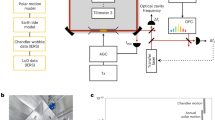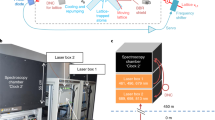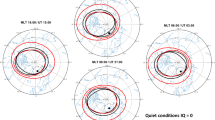Abstract
SINCE ATS-6 was launched into a geostationary orbit at 94°W in late May 1974, measurements of the total electron content (TEC) using the Faraday polarisation-rotation1 and group dispersive-delay techniques have been made at Fort Monmouth (40.18°N; 74.06°W). Comparison of TEC rate of change obtained by the two techniques yields the temporal variation of the integrated number of free electrons above the ionosphere. This variation indicates a flow of electrons from regions above the ionosphere into the ionosphere at night, while during the day the direction of flow is reversed. The rate of the electron flux is estimated using the continuity equation.
This is a preview of subscription content, access via your institution
Access options
Subscribe to this journal
Receive 51 print issues and online access
$199.00 per year
only $3.90 per issue
Buy this article
- Purchase on Springer Link
- Instant access to full article PDF
Prices may be subject to local taxes which are calculated during checkout
Similar content being viewed by others
References
Soicher, H., and Gorman, F. Jr, Joint Satellite Studies Group Rpt No. 5, 109, (Lannion, France, 1974).
Koehler, R. L., J. geophys. Res., 73, 15, 4883 (1968).
Arendt, P. R., and Soicher, H., Nature, 204, 983 (1964).
Tyagi, T. R., J. atmos. terr. Phys., 36, 475 (1974).
Bertin, F., Radio Sci., 5, 899 (1970).
Author information
Authors and Affiliations
Rights and permissions
About this article
Cite this article
SOICHER, H. ATS-6 radio beacon experiment. Nature 253, 252–254 (1975). https://doi.org/10.1038/253252a0
Received:
Revised:
Issue Date:
DOI: https://doi.org/10.1038/253252a0
This article is cited by
-
Longitudinal dependence of ionospheric total electron content in the South Atlantic Geomagnetic Anomaly
Nature (1976)
-
Comparative ionospheric and plasmaspheric electron contents from three world regions
Nature (1976)
-
Response of electrons in ionosphere and plasmasphere to magnetic storms
Nature (1976)
Comments
By submitting a comment you agree to abide by our Terms and Community Guidelines. If you find something abusive or that does not comply with our terms or guidelines please flag it as inappropriate.



